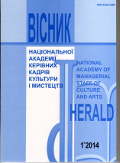THE HISTORY OF ADVERTISING FORMATION: WORK ON SCIENTIFIC LITERATURE
DOI:
https://doi.org/10.32461/2226-3209.1.2014.137898Keywords:
history of advertising, advertising, vectors of advertising, historical conditions, development of advertisingAbstract
In the article we analyzed foreigner and native scientific heritage that considered problem of developmentadvertising in the specific historical periods. Stressed on social and cultural context and identified factors of influence,both negative and positive. The role of advertising researched in a particular historical time, since the days of antiquity,when first hatched commercials and the beginning of the XXI century. Playing status and trends of advertising as aphenomenon of modern culture, based on the historical traditions of formation and development.Nowadays we can see a great attention to term "advertising". Specialists of different spheres try to show theirown understanding and meaning of advertising, they try to identify main characteristics of this phenomenon, to give owndefinition. We believe that in order to understand the specificity of this phenomenon, first of all it is necessary to refer toits origin, to distinguish stages of development. The purpose of this article is to determine the main vectors of advertisingin the context of a given historical conditions.
Question of the history and formation of advertising rises in the work of international theorists such as L.Burnett, K. Bove, G. Gallup, A. Lasker, and D. Ogilvie.L. Kornilov, S. Pankratov, N. Staryh, V. Uchenova, A. Feofanov, and L. Shkolnik are the most famous Russiantheorists that investigated problem of advertising historical periods.
Thus, the emergence of advertising in ancient times, dedicated to studies of Russian theorist S. Pankratov. He based onarchaeological finds, which, according to theorist, confirming the existence of advertising in this period. His work "Advertising Business"is filled with references to the sayings of ancient philosophers that make possible to see the social and political foundations ofadvertising. Another Russian scientist L. Shkolnik examines everyday verbal information that comes from the streets; it is a kind of adsand signs. Theorist examines the distribution of linguistic errors that were present from the first adverting messages.
L. Kornilov in his work "From crier to neon" a name that speaks for itself (the evolution of advertising fromancient crier to modern neon lights), focusing on representations of the Renaissance artists, through their work trying toshow aspects of the self-promotion.
Collaborators V. Uchenova and N. Staryh distinguished promotional image and traces its modification forcenturies. In the XX century V. Uchenova is one of the most famous explorers of advertising. A. Feofanov also is aleading specialist in the theory and history of advertising. In his research, he is trying to stress on the specific features ofthe Russian advertising, explores the peculiarities of Soviet advertising. However, there are a lot of works dedicated to the various aspects of advertising, in our view, they are not fullenough, and they have to be more systematic.
At the end of the twentieth century from small business agencies and individuals advertising has become aglobal industry where every day thousands of workers employed. Advertising has become an integral part of the globaleconomy, being one of the key aspects of markets. At the same time, advertising is an inexhaustible source ofemergence of new creative ideas. It is presented as an integral part of human life. Moreover, advertising highlighted inresearch and education and subject taught in universities. For example, in the U.S. advertising business courses aretaught in more than a hundred high schools and some of them have the right to confer degrees.
In this article, we would like to emphasize that the development of advertising goes back to primitive times,when there was a division of labor, and became necessary to exchange items. We had interest about advantages anddisadvantages of the object. With the development of mankind, forms the structure of society and ownership advertisingchanged itself, its methods of display types. In feudal society, there is an equivalent exchange of goods – money, andthe trade is presented as an intermediary between the seller and buyer, the effect of which becomes profit. Then, in themiddle XVIII century became to develop market relations. A large number of products demanded more information aboutthe products, their properties cause rapid development of advertising. It is clear that word of oral advertising and minorannouncements and signage becomes insufficient, therefore, to advertise products or services are beginning to distributethe printed posters and flyers to use print media – newspapers and magazines. In the XIX century started their workadvertising agencies that provided specific company or advertising publications.
With the development of science and technology appeared a new ways of conveying information, such as radio,television, the Internet. Any mass media begin to distribute advertising. Thus, to draw conclusions about modernadvertising too early, but it should be noted that it is guided by interpretive and communicative space. Today'scommercials are among a number of other visual displays, but need something bigger, more meaningful, more creativeand more expressive. They should immediately impress, thereby paying attention of potential consumers.
Downloads
Published
Issue
Section
License
Authors who publish with this journal agree to the following terms:
1. Authors retain copyright and grant the journal right of first publication with the work simultaneously licensed under a Creative Commons Attribution License International CC-BY that allows others to share the work with an acknowledgement of the work's authorship and initial publication in this journal.
2. Authors are able to enter into separate, additional contractual arrangements for the non-exclusive distribution of the journal's published version of the work (e.g., post it to an institutional repository or publish it in a book), with an acknowledgement of its initial publication in this journal.
3. Authors are permitted and encouraged to post their work online (e.g., in institutional repositories or on their website) prior to and during the submission process, as it can lead to productive exchanges, as well as earlier and greater citation of published work (See The Effect of Open Access).


